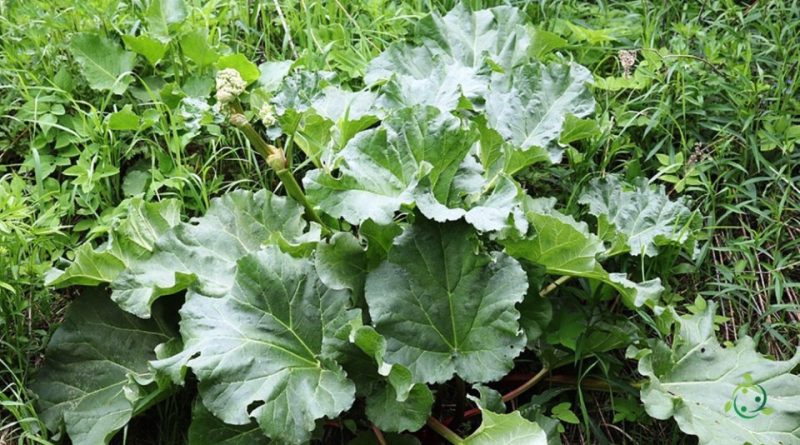Nutritional value of Rhubarb
Nutritional value of Rhubarb
Rhubarb (Rheum rhabarbarum L.) is a perennial, rhizomatous herbaceous plant belonging to the Polygonaceae family.
Characteristics –
Rhubarb is a perennial plant native to Central Asia. It is grown for its edible stems, known for their tart, acidic flavor, which is often used in cooking to make desserts, jams, preserves, and drinks such as rhubarb lemonades.
Rhubarb is a perennial herbaceous plant that grows up to one meter in height. It has large green leaves that can be quite showy, with long, thick stems emerging from the base. The stems are the edible part of the plant and can range in color from light green to red, depending on the variety.
Rhubarb leaves are large, heart-shaped and lobed, with prominent veins. They are generally toxic to humans due to their calcium oxalate content, and therefore should never be consumed.
Rhubarb stalks are why this plant is grown. They are thick, meaty and have a sour, acidic flavor. The stems are harvested when they are young, before they become too fibrous, usually in spring or early summer.
Rhubarb produces flowers, but it is generally recommended to remove them to ensure vigorous growth of the stems. The flowers are small, green-yellow in color.
Rhubarb is a hardy plant that grows well in temperate climates. It is cold hardy and can survive the winter. It is traditionally grown in gardens and allotments and requires little intervention if well rooted.
Rhubarb stalks are used in a variety of culinary recipes, including pies, tarts, jams, sauces and drinks. However, due to their sour taste, they are often combined with sugar or other sweeteners to balance the taste.
Rhubarb is a good source of vitamins, including vitamin C and B vitamins, as well as minerals such as potassium. However, it also contains oxalates, which can be harmful in large quantities for some people with a predisposition to kidney problems.
It is important to note that rhubarb leaves are toxic and should never be consumed. Only the ripe stems are safe for consumption.
Nutritional sheet –
Here is an approximate nutritional sheet for raw rhubarb (per 100 grams of edible portion):
– Calories: 21 kcal
– Protein: 0.9 grams
– Carbohydrates: 4.9 grams
– Sugars: 1.1 grams
– Fibers: 2 grams
– Fat: 0.2 grams
– Vitamin C: 8.2 milligrams (about 14% of the recommended daily intake)
– Vitamin K: 29.3 micrograms (about 37% of the recommended daily intake)
– Potassium: 288 milligrams
– Calcium: 86 milligrams
– Magnesium: 12 milligrams
It is important to note that nutritional values may vary slightly depending on the rhubarb variety and cooking method. Rhubarb is known for its sour flavor due to the oxalic acid present in its leaves, which are toxic if consumed. Therefore, when using rhubarb in cooking, it is important to make sure you remove the leaves and only use the stems.
It is also recommended that you consult a health professional or dietician for more detailed nutrition information and specific nutrient amounts based on your individual dietary needs.
Property –
Rhubarb is a plant known for its culinary and medicinal properties and uses.
Rhubarb is often used as a natural laxative due to its content of compounds such as anthraquinones, which can help promote bowel regularity. However, excessive use of rhubarb as a laxative can cause problems, so it is important to consume it in moderation.
Rhubarb contains antioxidants, such as vitamin C and polyphenols, which can help fight oxidative stress in the body.
Rhubarb is a good source of vitamin K, vitamin C, calcium and potassium. These nutrients are important for bone health, the immune system and the proper functioning of the body.
Some preliminary studies suggest that rhubarb may have anti-inflammatory effects, but further research is needed to confirm these benefits.
Rhubarb has traditionally been used to improve digestion, particularly after heavy meals, due to its laxative properties and ability to stimulate bile production.
Some compounds in rhubarb may have a positive impact on cholesterol management, but scientific evidence is limited and further studies are needed.
It is important to note that rhubarb also contains oxalates, which can be harmful if consumed in large quantities, as they can contribute to the formation of kidney stones. Therefore, excessive consumption of rhubarb should be avoided. Additionally, rhubarb is not suitable for everyone, and it is advisable to consult a medical professional or nutritionist before using it for medicinal purposes, especially if you have pre-existing medical conditions or are taking medications.

